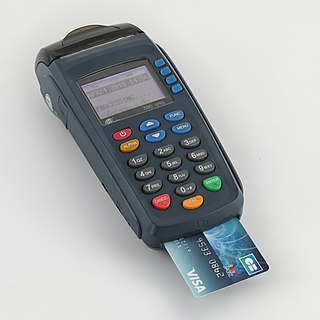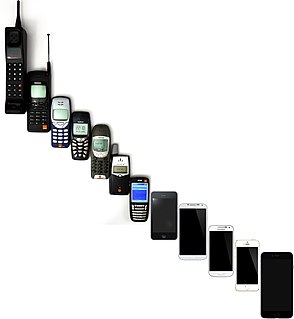Related Research Articles

A smart card, chip card, or integrated circuit card is a physical electronic authorization device, used to control access to a resource. It is typically a plastic credit card-sized card with an embedded integrated circuit (IC) chip. Many smart cards include a pattern of metal contacts to electrically connect to the internal chip. Others are contactless, and some are both. Smart cards can provide personal identification, authentication, data storage, and application processing. Applications include identification, financial, mobile phones (SIM), public transit, computer security, schools, and healthcare. Smart cards may provide strong security authentication for single sign-on (SSO) within organizations. Numerous nations have deployed smart cards throughout their populations.

A SIM card, is an integrated circuit (IC) intended to securely store the international mobile subscriber identity (IMSI) number and its related key, which are used to identify and authenticate subscribers on mobile telephony devices. Technically the actual physical card is known as a universal integrated circuit card (UICC); this smart card is usually made of PVC with embedded contacts and semiconductors, with the SIM as its primary component. In practise the term "SIM card" refers to the entire unit and not simply the IC.

Mobile payment generally refer to payment services operated under financial regulation and performed from or via a mobile device. Instead of paying with cash, cheque, or credit cards, a consumer can use a mobile to pay for a wide range of services and digital or hard goods. Although the concept of using non-coin-based currency systems has a long history, it is only in the 21st century that the technology to support such systems has become widely available.

Near-field communication (NFC) is a set of communication protocols that enables communication between two electronic devices over a distance of 4 cm or less. NFC offers a low-speed connection through a simple setup that can be used to bootstrap more-capable wireless connections. Like other "proximity card" technologies, NFC is based on inductive coupling between two so-called antennas present on NFC-enabled devices—for example a smartphone and a printer—communicating in one or both directions, using a frequency of 13.56 MHz in the globally available unlicensed radio frequency ISM band using the ISO/IEC 18000-3 air interface standard at data rates ranging from 106 to 424 kbit/s.

A mobile device is a computer small enough to hold and operate in the hand. Typically, any handheld computer device will have an LCD or OLED flat screen interface, providing a touchscreen interface with digital buttons and keyboard or physical buttons along with a physical keyboard. Many such devices can connect to the Internet and interconnect with other devices such as car entertainment systems or headsets via Wi-Fi, Bluetooth, cellular networks or near field communication (NFC). Integrated cameras, the ability to place and receive voice and video telephone calls, video games, and Global Positioning System (GPS) capabilities are common. Power is typically provided by a lithium-ion battery. Mobile devices may run mobile operating systems that allow third-party applications to be installed and run.
MIFARE is the NXP Semiconductors-owned trademark of a series of integrated circuit (IC) chips used in contactless smart cards and proximity cards.

The features of mobile phones are the set of capabilities, services and applications that they offer to their users. Mobile phones are often referred to as feature phones, and offer basic telephony. Handsets with more advanced computing ability through the use of native code try to differentiate their own products by implementing additional functions to make them more attractive to consumers. This has led to great innovation in mobile phone development over the past 20 years.
Java Card OpenPlatform (JCOP) is a smart card operating system for the Java Card platform developed by IBM Zürich Research Laboratory. On 31 January 2006 the development and support responsibilities transferred to the IBM Smart Card Technology team in Böblingen, Germany. Since July 2007 support and development activities for the JCOP operating system on NXP / Philips silicon are serviced by NXP Semiconductors.

A contactless smart card is a contactless credential whose dimensions are credit-card size. Its embedded integrated circuits can store data and communicate with a terminal via NFC. Commonplace uses include transit tickets, bank cards and passports.

Contactless payment systems are credit cards and debit cards, key fobs, smart cards, or other devices, including smartphones and other mobile devices, that use radio-frequency identification (RFID) or near-field communication for making secure payments. The embedded integrated circuit chip and antenna enable consumers to wave their card, fob, or handheld device over a reader at the point of sale terminal. Contactless payments are made in close physical proximity, unlike other types of mobile payments which use broad-area cellular or WiFi networks and do not involve close physical proximity.
A datacard is an electronic card for data operations.
SIM Application Toolkit (STK) is a standard of the GSM system which enables the subscriber identity module to initiate actions which can be used for various value-added services. Similar standards exist for other network and card systems, with the USIM Application Toolkit (USAT) for USIMs used by newer-generation networks being an example. A more general name for this class of Java Card-based applications running on UICC cards is the Card Application Toolkit (CAT).

A payment terminal, also known as a point of sale (POS) terminal, credit card terminal, EFTPOS terminal, is a device which interfaces with payment cards to make electronic funds transfers. The terminal typically consists of a secure keypad for entering PIN, a screen, a means of capturing information from payments cards and a network connection to access the payment network for authorization.

A mobile phone, cellular phone, cell phone, cellphone, handphone, hand phone or pocket phone, sometimes shortened to simply mobile, cell, or just phone, is a portable telephone that can make and receive calls over a radio frequency link while the user is moving within a telephone service area. The radio frequency link establishes a connection to the switching systems of a mobile phone operator, which provides access to the public switched telephone network (PSTN). Modern mobile telephone services use a cellular network architecture and, therefore, mobile telephones are called cellular telephones or cell phones in North America. In addition to telephony, digital mobile phones (2G) support a variety of other services, such as text messaging, MMS, email, Internet access, short-range wireless communications, business applications, video games and digital photography. Mobile phones offering only those capabilities are known as feature phones; mobile phones which offer greatly advanced computing capabilities are referred to as smartphones.
InterChip USB (IC-USB), sometimes referred to as USB-IC or Inter-chip USB, is an addendum to the USB Implementers Forum (USB-IF) USB 2.0 specification. IC-USB is intended as a low-power variant of the standard physical USB interface, intended for direct chip-to-chip communications. The IC-USB bus's maximum length of 10 cm results in a lower inductance and capacitance and therefore allows lower power requirements. IC-USB is used primarily in embedded systems; for example, ETSI has standardized on IC-USB as the official high-speed interface for connections between the main chipset of a smartphone and the SIM card or UICC card.
Payanywhere is a payments platform and app that allows merchants in the United States to accept credit and debit card payments while building customer relationships in-store, online, or on the go. Merchants may accept payments on their smartphone via a Bluetooth card reader or on an in-store “Storefront” solution featuring a tablet and stand, which was introduced on April 8, 2014. PayAnywhere offers credit card readers and apps that are compatible with both Apple and Android devices.
Microsoft Pay is a mobile payment and digital wallet service by Microsoft that lets users make payments and store loyalty cards on certain devices. Making payments is currently supported on the Microsoft Edge browser. Microsoft Pay does not require Microsoft Pay-specific contactless payment terminals, and can work with existing contactless terminals if used on mobile devices. Similar to Android Pay, Microsoft Pay utilizes host card emulation (HCE) for making in-store payments.
An eSIM (embedded-SIM) is a form of programmable SIM card that is embedded directly into a device. Instead of an integrated circuit located on a removable universal integrated circuit card (UICC), typically made of PVC, an eSIM consists of software installed onto an eUICC chip permanently attached to a device.
Magnetic secure transmission (MST) is the name for mobile payment technology in which devices such as smartphones emit a signal that mimics the magnetic stripe on a traditional payment card.
References
- ↑ ETSI TS 102 613 V.11.0.0 - UICC-CLF Interface; Part 1: Physical and data link layer characteristics (Release 11), 2011-09
- ↑ ETSI TS 102 622 V.12.1.0 - UICC-CLF Interface; Host Controller Interface (HCI)m 2014-10 (Release 12)
- ↑ "SCP Activity Report 2007". 7 July 2008.
- ↑ "The future of the SIM hangs by a single wire". The Register .
- ↑ "Archived copy" (PDF). www.gsmworld.com. Archived from the original (PDF) on 30 December 2008. Retrieved 22 May 2022.
{{cite web}}: CS1 maint: archived copy as title (link) - ↑ "Nokia's 2011 Smartphones Have Built-In Wireless Payment Tech: Take That, Apple!". 18 June 2010.